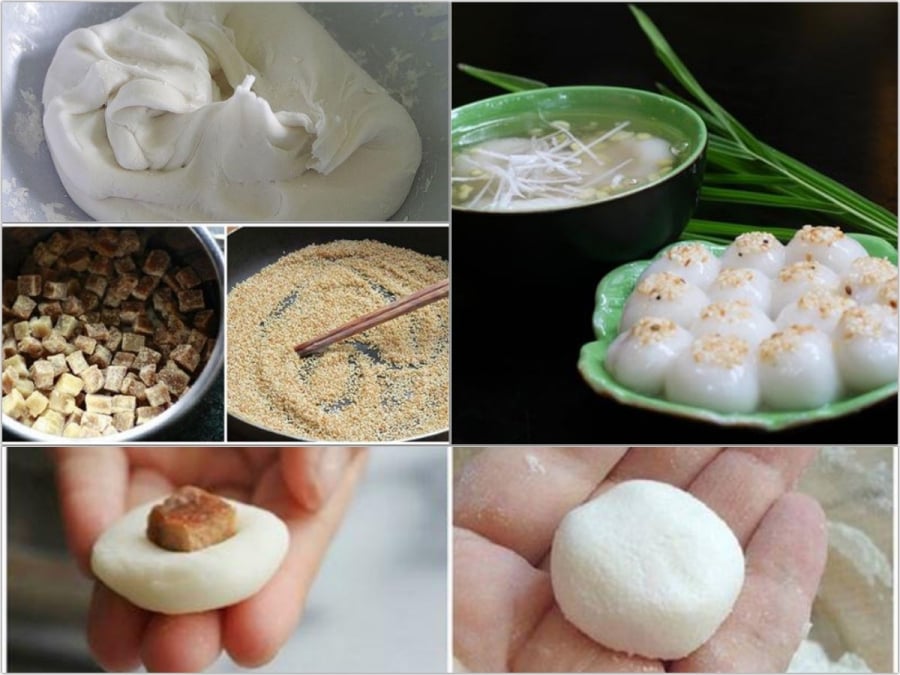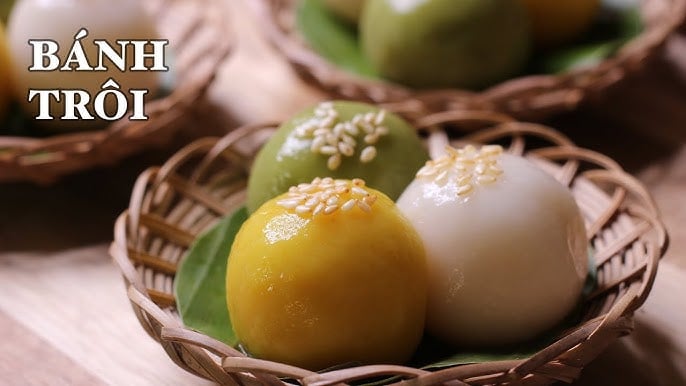
How to Make Banh Troi and Banh Chay for Han Thuc Festival
The tradition of eating Banh Troi and Banh Chay on Han Thuc Festival has deep roots in the consciousness of Vietnamese people. During this time, regardless of where they are or what they are doing, families prepare elaborate offerings, including Banh Troi and Banh Chay, to worship Buddha and ancestors, expressing their sincerity and connection to their roots.
Banh Troi and Banh Chay are not just familiar folk foods but also carry the imprint of traditional values. Every year, on Han Thuc Festival (3rd day of the 3rd lunar month), families gather to make these delicacies, remembering their ancestors and honoring their heritage.
Enjoying Banh Troi and Banh Chay is more than a culinary experience; it’s a nostalgic journey, evoking sacred and meaningful sentiments in life.
Ingredients for Banh Troi
To make Banh Troi, you’ll need the following basic ingredients:
Glutinous rice flour: This is the main ingredient that determines the softness and elasticity of the cake. Choose high-quality, fine, and white glutinous rice flour.
Mung beans: Used for the filling, they need to be soaked, cooked until soft, and then mashed.
Rock sugar: Rock sugar gives the honey a clear and mild sweetness without being overpowering.
Coconut milk (optional): Coconut milk adds richness and aroma to the cake.
Ginger: Ginger enhances the distinctive flavor and prevents honey leakage during long-term storage.
Steps to Make Soft and Delicious Banh Troi
1. Prepare the dough
The dough for Banh Troi needs to be kneaded thoroughly so that the cakes are soft, elastic, and don’t crack after boiling. Here’s the standard method:
Place glutinous rice flour in a large bowl, gradually add warm water, and stir until the flour absorbs the water.
Knead the dough until it’s soft, smooth, and no longer sticky. Let the dough rest for about 10-15 minutes.
During kneading, if the dough feels too dry, you can add a small amount of water to soften it. However, avoid adding too much water, as it will make the dough sticky and difficult to shape.
2. Make the filling
Mung bean filling is an essential component of Banh Troi. To make a nutty-sweet filling, follow these steps:
Soak mung beans in water for 2-3 hours to soften them, then steam or boil until cooked.
After cooking, mash the beans and mix them with sugar. You can add a touch of vanilla for a distinctive aroma.
Shape the mung bean mixture into small balls, approximately 10-12g each, depending on your desired cake size.
3. Shape the cakes
Take a small portion of the kneaded dough, flatten it in the palm of your hand, place the filling in the center, and gradually enclose it, ensuring that the filling doesn’t escape.
Shape the dough into smooth, round balls.
Note: Avoid making the cakes too big or too small. If they’re too large, they may crack during boiling; if they’re too small, they tend to become hard and won’t have the desired softness.
4. Boil the cakes
Bring water to a boil in a pot with a pinch of salt. Once the water is boiling, gently place the cakes into the pot.
Continue boiling for about 5-7 minutes after the cakes float to the surface to ensure they are thoroughly cooked.
To prevent stickiness, immediately transfer the cakes to a bowl of cold water after boiling. This helps retain their softness and prevents honey leakage.

5. Make the honey syrup
Boil rock sugar with water until the sugar dissolves completely and the mixture thickens slightly. For clearer and more fragrant honey, you can add fresh ginger slices.
After boiling, you can add coconut milk and stir to create a rich, creamy syrup.
6. Finalize the Banh Troi
Remove the cakes from the water and place them in a bowl. Drizzle the prepared honey syrup over them, and sprinkle with roasted sesame seeds for added flavor and decoration.
Let the cakes rest for a few minutes before serving to allow them to absorb the honey and become even more tempting.
The Secret to Preventing Honey Leakage and Spoilage
Coconut milk and ginger: Using a small amount of ginger in the filling and boiling water helps prevent spoilage and stops the honey from leaking out during storage.
Cake storage: To prevent honey leakage and spoilage, store the cakes in an airtight container after they have cooled down. They can be kept in the refrigerator to extend their freshness.
Using rock sugar: When boiled into honey, rock sugar helps prevent rapid leakage, maintains clarity and mild sweetness, and adds elasticity to the filling.
Tips for Making Perfect Banh Troi
Avoid using too much water when making the dough: Excess water will make the dough sticky, causing the cakes to become brittle instead of soft and elastic.
Choose high-quality glutinous rice flour: The quality of the flour significantly impacts the softness and elasticity of the cakes, so opt for a reputable brand.
When boiling the cakes, don’t crowd the pot: This ensures that the cakes don’t stick together and allows them to cook evenly.
With these tips and tricks for making Banh Troi, you’ll be able to create soft and delicious cakes that won’t leak honey, even when stored for extended periods. Banh Troi is not just a traditional festival food but also a wonderful breakfast or afternoon treat to share with your loved ones. Good luck, and enjoy your delicious Banh Troi!
The Ultimate Guide to Choosing Fruits for the Lunar Month-End Offering: 5 Things to Avoid for a Prosperous and Lucky New Year
Preparing offerings for the Full Moon Festival in the twelfth lunar month is not just an act of reverence but also a way to attract wealth, peace, and luck for the entire family. Hence, the host must pay special attention to selecting fruits that are fresh, dignified, and aligned with Feng Shui principles.



































